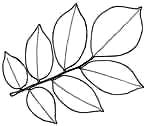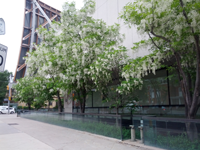Kentucky yellow-wood
Virgilia
Cladrastis kentukea (Dum. Cours.) RuddFabaceae (Legume family)Origin: Southeastern U.S.A.

Origin: Southeastern U.S.A.

Kentucky yellow-wood is a small to medium-sized tree, usually with a forking trunk and a broad crown.
Read more about Tree, Bark, TwigsKentucky yellow-wood is a small to medium-sized tree, about 9 - 15 m (30' - 50'), usually with a broad crown.
Leaves are about 25 cm (10") long, pinnately compound with 7 - 11 oval leaflets up to 10 cm (4") long.
Leaflets have smooth edges and pointed tips and are offset on the leaf stalk (rachis), rather than in opposite pairs like most compound leaves, .
Leaves have an alternate arrangement on the branch. (Note that the base of the leaf stalks are swollen but the base of the leaflet stalks are not.)
Distribution
Kentucky yellow-wood is an uncommon tree in the wild and is native to the American southeast, but occurs in pockets as far north as Illinois and Indiana. The tree has been planted in the American northeast and Canada, as well as in Europe, to which its seeds were exported in the early 1800s.Derivation of names
The genus name, Cladrastis, comes from the Greek words klados, meaning branch, and thraustos, meaning fragile, in reference to the tree's brittle twigs. The species name, kentukea, means "from Kentucky".
Cladrastis kentukea was previously called Cladrastis lutea, but this name is now out of date. Lutea comes from the Latin for golden-yellow.
The name yellow-wood refers to the tree's bright yellow heart wood, which turns brown shortly after it is cut.
Commercial use
The bark of the tree's roots was used by pioneers to produce a yellow dye for clothing. The wood has been used to manufacture gun stocks, but due to the rarity of the species in the wild, it has not been widely harvested.
Related species
Japanese yellow-wood, Cladrastis platycarpa, is not commonly cultivated. It differs from Kentucky yellow-wood in its upright (rather than hanging) flower clusters and its slightly hairy, more numerous leaflets.
Kentucky yellow-wood's place in Toronto's urban forest
 Despite its natural southern range, Kentucky yellow-wood has proved hardy in northern regions, including Ontario and the American Northeast, where it has been planted for its attractive foliage and flowers. Though not very common, the trend to increase the diversity of trees has led to this species being planted more often on Toronto's streets and in parks. There is a row of yellow-woods along the west side of the Art Gallery of Ontario as in this photo on the right.
Despite its natural southern range, Kentucky yellow-wood has proved hardy in northern regions, including Ontario and the American Northeast, where it has been planted for its attractive foliage and flowers. Though not very common, the trend to increase the diversity of trees has led to this species being planted more often on Toronto's streets and in parks. There is a row of yellow-woods along the west side of the Art Gallery of Ontario as in this photo on the right.
Landscape value and potential for home planting
Pests and diseases: Kentucky yellow-wood is relatively free of insect pests and diseases. It has been known to suffer from Verticillum wilt, which is caused by a fungus living in soil and leads to sudden leaf wilting. Wilting may be localized on one or two branches, or the entire canopy may be affected. The tree may not necessarily die from the infection.
This tree is available for planting through the City of Toronto's street tree program.
Links to maps at Canadian Tree Tours: